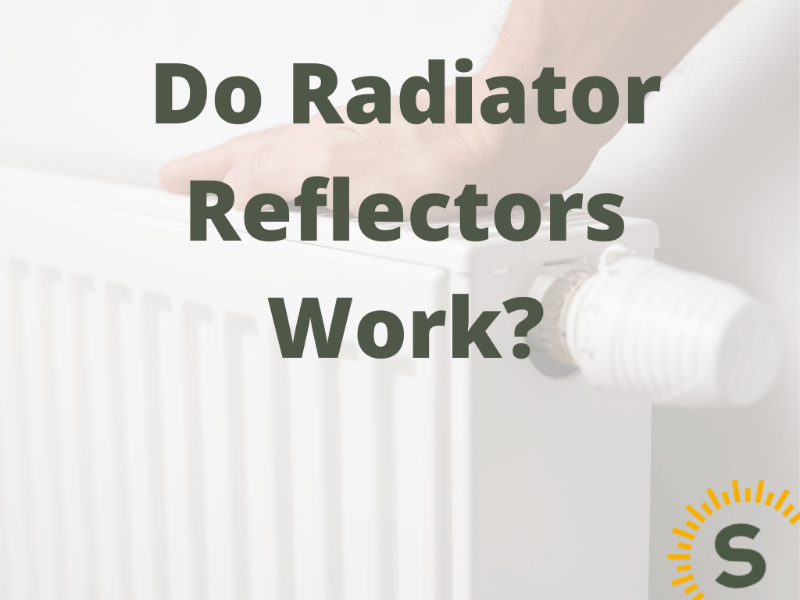
Radiator reflectors are an innovative solution to improve the efficiency of heating systems. But, do Radiator reflectors work?
Yes. Radiator reflectors emerge as a practical and cost-effective solution to enhance heating efficiency. By redirecting heat into living spaces, these reflective sheets promote even warmth, potentially reducing energy consumption and utility bills.
Here is our preferred option:
 £35.93
£35.93Radiator reflectors improve heating efficiency by blocking heat loss. Made of materials like foil, these sheets, when placed behind radiators, reflect heat into the room instead of letting it absorb into walls. This redirects heat evenly, making rooms warmer. Note: they work best in rooms with solid walls, not as well in insulated or cavity-wall rooms.
The use of radiator reflectors offers a range of benefits for homeowners and renters alike. Let's take a closer look at some of these advantages:
The primary benefit of radiator reflectors is the improved heat distribution within a room. By reflecting heat back into the room, reflectors ensure that warmth is evenly spread, eliminating cold spots and creating a more comfortable living environment.
By maximising the heat output of radiators, reflectors can potentially reduce energy consumption. With more heat staying in the room rather than being absorbed by the wall, the heating system doesn't need to work as hard to maintain a comfortable temperature. This can lead to lower energy bills and reduced carbon footprint.
Installing radiator reflectors is a straightforward process that can be easily done by homeowners or renters. Reflectors are typically attached to the wall using adhesive pads or magnetic strips, and they can be easily removed without causing any damage.
Compared to other methods of improving heating efficiency, such as replacing radiators or insulating walls, radiator reflectors are a cost-effective solution. They offer a significant improvement in heat distribution at a fraction of the cost.
Radiator reflectors can be used with various types of heating systems, including gas boilers, electric heaters, and even renewable energy sources such as heat pumps. This makes them a versatile option for improving heating efficiency in different settings.
Radiator reflectors come in various types, each offering unique features and benefits. Let's take a closer look at the most common types of radiator reflectors available in the market:
Foil reflectors are the most basic and commonly used type of radiator reflectors. They are made of a thin layer of aluminum foil and typically come in rolls or sheets. Foil reflectors are easy to install and provide a good level of heat reflection, making them a popular choice among homeowners.
Rigid panel reflectors are made of a more solid material, such as polystyrene or aluminum composite. They offer a higher level of insulation compared to foil reflectors and provide better heat reflection. Rigid panel reflectors are often used in rooms with cavity walls or insulation, where the effectiveness of foil reflectors may be reduced.
Reflective wallpaper is a more aesthetically pleasing option for those who want to improve heat distribution while maintaining a stylish interior. It is made of a thin layer of aluminum or foil and can be applied directly to the wall, similar to regular wallpaper. Reflective wallpaper combines the benefits of heat reflection with a decorative element, making it a popular choice among homeowners.
While not technically reflectors, radiator shelves can also help improve heat distribution. They work by preventing warm air from rising directly to the ceiling, allowing it to circulate in the room for longer. Radiator shelves are available in various materials and designs, making them a versatile option for enhancing the efficiency of radiators.
Installing radiator reflectors is a relatively simple process that can be done by homeowners or renters without the need for professional assistance. Here's a step-by-step guide to help you install radiator reflectors effectively:
Start by measuring the height and width of the radiator and cut the reflector material accordingly. It's important to leave a few centimetres of excess material on each side to ensure proper coverage.
Before applying the reflector, make sure the wall behind the radiator is clean and free from dust or grease. Use a mild detergent solution and a clean cloth to wipe the wall and remove any dirt or residue.
Depending on the type of reflector you're using, you can attach it to the wall using adhesive pads, magnetic strips, or even double-sided tape. Follow the manufacturer's instructions for the specific type of reflector you have.
Once the reflector is attached to the wall, use a clean cloth or a soft brush to smooth out any wrinkles or air bubbles. This will ensure that the reflector is properly adhered to the wall and maximises heat reflection.
If there is any excess material sticking out from the edges of the reflector, use a sharp pair of scissors or a utility knife to trim it neatly. This will give the installation a clean and professional look.
After installing the reflector, carefully inspect the edges and corners to ensure there are no gaps or areas where heat can escape. If necessary, apply additional adhesive or tape to seal any gaps and maximise heat reflection.
While radiator reflectors are a great solution for improving heat distribution, there are a few tips and tricks that can help you maximise their effectiveness. Here are some recommendations to get the most out of your radiator reflectors:
To ensure maximum heat reflection, make sure the reflector covers the entire area behind the radiator. Any gaps or uncovered areas can allow heat to escape, reducing the effectiveness of the reflector.
Over time, dust and dirt can accumulate on the surface of the reflector, reducing its ability to reflect heat. Regularly clean the reflector using a soft cloth or a gentle cleaner to remove any dirt or debris.
Experiment with the angle of the reflector to find the optimal position for heat reflection. In some cases, angling the reflector slightly upwards can help redirect heat more effectively into the room.
If possible, consider using reflective materials for the walls surrounding the radiator. This can further enhance heat reflection and improve overall heat distribution within the room.
While radiator reflectors can significantly improve heat distribution, it's important to ensure that the rest of the room is well-insulated. Proper insulation can prevent heat loss through windows, doors, and walls, further enhancing the effectiveness of reflectors.
With any innovative solution, there are bound to be misconceptions and myths surrounding its effectiveness. Let's debunk some of the common misconceptions about radiator reflectors:
While it's true that radiator reflectors work best in rooms with solid walls, they can still provide benefits in other types of properties. Even in rooms with cavity walls or insulation, reflectors can improve heat distribution to some extent.
While radiator reflectors are most commonly associated with improving heating efficiency during the winter months, they can provide benefits throughout the year. By maximising heat distribution, reflectors can help maintain a comfortable temperature regardless of the season.
Compared to other methods of improving heating efficiency, radiator reflectors are a cost-effective solution. They offer a significant improvement in heat distribution at a fraction of the cost of replacing radiators or insulating walls.
Radiator reflectors are designed to be easily installed by homeowners or renters without the need for professional assistance. With simple adhesive pads or magnetic strips, reflectors can be attached to the wall quickly and easily.
While modern insulation materials can reduce the effectiveness of radiator reflectors to some extent, they can still provide noticeable improvements in heat distribution. It's important to consider the overall energy efficiency of the room and use reflectors in conjunction with proper insulation.
Consider these alternatives to enhance radiator performance:
Radiator reflectors provide a simple, effective solution, enhancing heating system efficiency by reflecting heat into the room. Explored in this article are their benefits, installation, cost savings, and debunked myths. While great for efficiency, consider alternatives like insulation panels and radiator upgrades. Whether homeowner or renter, reflectors optimise heat distribution, reduce energy use, and offer a cost-effective solution for a warmer living space.
Combat winter chills by installing radiator reflectors and enjoy an energy-efficient home.

Stuart is an expert in Property, Money, Banking & Finance, having worked in retail and investment banking for 10+ years before founding Sunny Avenue. Stuart has spent his career studying finance. He holds qualifications in financial studies, mortgage advice & practice, banking operations, dealing & financial markets, derivatives, securities & investments.





Our website offers information about financial products such as investing, savings, equity release, mortgages, and insurance. None of the information on Sunny Avenue constitutes personal advice. Sunny Avenue does not offer any of these services directly and we only act as a directory service to connect you to the experts. If you require further information to proceed you will need to request advice, for example from the financial advisers listed. If you decide to invest, read the important investment notes provided first, decide how to proceed on your own basis, and remember that investments can go up and down in value, so you could get back less than you put in.
Think carefully before securing debts against your home. A mortgage is a loan secured on your home, which you could lose if you do not keep up your mortgage payments. Check that any mortgage will meet your needs if you want to move or sell your home or you want your family to inherit it. If you are in any doubt, seek independent advice.